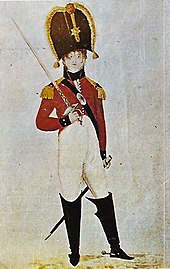Senior Citizens' Convention in Frankfurt (Oder)
The SC zu Frankfurt (Oder) was a senior citizens' convent (university) at the Brandenburg University of Frankfurt . In 1998 he was resurrected with a corps at the European University Viadrina .
history
1798
The Brandenburg University of Frankfurt, founded in 1506, was divided into four nations as self-governing bodies , following the pattern of Charles University in Prague and Leipzig University ; in Frankfurt it was those of the Märker , Franconians , Silesians and Prussians . In addition to this official division, private country associations developed that shaped the social life of the students. In the second half of the 18th century, based on the won Freemasonry founded student religious finally a dominant position. Excessive comments aroused the displeasure of some friars and other students. Under the leadership of a student from the Mark Brandenburg region , they founded the Märkisches Kränzchen , also known as the Märkische Gesellschaft , in 1786 as a counter-movement to the order . About a year later they divided it into four country teams or wreaths . After the main provinces of origin of their members, they called themselves Märker, Schlesier, Prussia (East and West Prussia) and Pomerania. They were each led and represented by senior citizens . In the “General Cartel Laws of the 4 respective Kränzchen at the University of Frankfurt aO” of February 16, 1798 - the first known SC comment - they regulated their relationship with one another. As a common purpose they set "the eradication of harmful religious associations and the maintenance of a reasonable student comment". In particular, they steered the dueling system into order. Friedrich Ludwig Jahn , who was a Frankfurt student in 1801 and belonged to the Order of Unitists , turned out to be her fiercest opponent . From 1800 to 1807 the SC consisted of three country teams because the Pomeranians temporarily joined the Märkern.
When the Viadrina was moved to Breslau , the Frankfurter SC dissolved in 1810/11. Prussians, Silesians and some of the Märkers continued their tradition in Breslau, the majority of the Märker relocated to the new Friedrich-Wilhelms-Universität Berlin and continued their Frankfurt tradition here.
1998
In July 1991 the new European University Viadrina was founded in Frankfurt , which should also accept a high proportion of Polish students. Corps Borussia-Polonia, established on June 22, 1995 as the first local student association, wanted to meet this goal . After its renunciation in the Kösener SC Association, for which three lengths in the Berlin SC were necessary, it was accepted into the Association on July 9, 1997. The 1998 oKC granted him SC rights; On July 5, 1998, the local spokesman officially established the reconstitution of the SC zu Frankfurt an der Oder. On May 28, 2000, the Corps Silesia, previously based in Cologne and Aachen, reconstituted in Frankfurt under the name Borusso-Silesia . It reciprocated the corpsmen and inactive members of Borussia-Polonia, who were suspended at the same time. It also enjoys SC rights, has been using the old name Silesia since December 7, 2007 and is affiliated with the Berlin Consensus Convent .
Individual evidence
- ↑ Erich Röhlke: About the Nationes of the Alma Mater Viadrina . Einst und Jetzt , Vol. 16 (1971), pp. 62-66.
- ↑ Erich Röhlke: About the Kränzianertum at the Viadrina [Frankfurt ad O. 1763 / 86-1811] . Einst und Jetzt, Vol. 17 (1972), pp. 113-125.
- ↑ Erich Bauer (ed.): 14 of the oldest SC comments before 1820 . Once and Now , special issue 1967, pp. 5–8.
- ^ Albert Marth: History of the Marchia Corps in Berlin . Berlin 1919.
- ↑ Jörg Loke: On the origin and brief history of the Corps Borussia-Polonia at the European University Frankfurt on the Oder (1997-2000) . Einst und Jetzt, Vol. 48 (2003), pp. 315-325.
